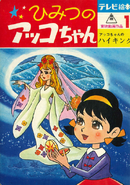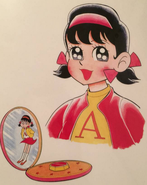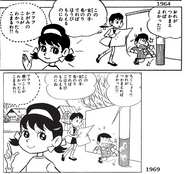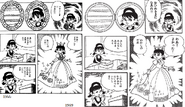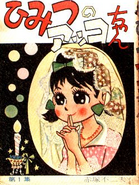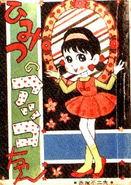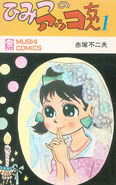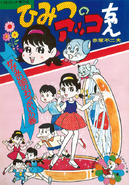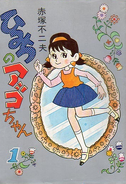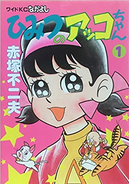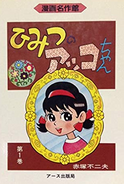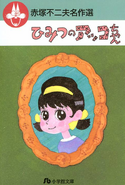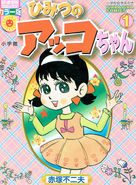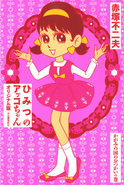Akko-chan's Got a Secret! (ひみつのアッコちゃん, Himitsu no Akko-chan), also known as The Secrets of Akko-chan, is a shojo manga and multimedia franchise by Fujio Akatsuka and Fujio Pro.
Overview[]
Loosely inspired by the 1942 film I Married a Witch. The fifth grader Akko (Atsuko Kagami) is gifted with a magic mirror that gives her the ability to transform into anything she wants. It is considered a pioneering work of the Magical Girl genre with this transformation tool, although its setting is more down-to-Earth and Akko isn't necessarily an action heroine type of character.
Akatsuka had come up with the inspiration for the series after seeing an article on Rene Clair's Witch in a magazine about overseas cinema. He decided to craft a work around a young girl that would transform using a magic object, in this case a mirror, and brought his idea to the Ribon editorial department. Although it was initially dismissed and thought of as too silly, Akatsuka insisted upon drawing it as it felt like an idea that nobody else but him was drawing now. The editors' hesitance would be proven wrong as Akko would soon become popular in the magazine.
The series marked a return to Akatsuka's shojo roots that had begun his career with Beyond the Storm. He relied on his then-wife Tomoko as his assistant to help him successfully convey a young girl's story; Tomoko was responsible for drafting several possible concept designs of Akko, which paved the way for Akatsuka to develop her characteristic hairstyle from some of the hair ideas that his wife presented. Tomoko would also be consulted for fashion ideas for Akko and other female characters in the series, which she would present various sketches. The names for some characters were developed from Tomoko and her own family as well; Akko was a nickname of her sister Akiko, Moko (along with the character's initial full name) was taken from her own name, and Kankichi was the name of her father.
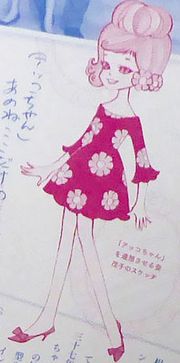
The first draft for an "Akko" by Tomoko.
As the work unfolds, our heroine gets into many tight situations with her mirror that will nonetheless be resolved in some way, or will use her transformations to learn secrets that she otherwise would not be privy to in order to figure out a solution. Nobody else may know of her abilities, though her grandfather becomes the only other character to learn about the mirror and use its power as well on a special occasion.
Like various other Akatsuka serial works of the time, the ending is left open and like any other chapter, allowing no consciousness of the series being over and leaving Akko's daily life adventures free to presumably continue on as they normally would. This is in contrast to its anime adaptations, which would usually have a critical moment that would require Akko to use her mirror for saving someone, only for the mirror to vanish or stop working as a result of its power being used up. In the case of the 1969 and 1998 anime, her item's fate is final, while the 1988 version leaves a loophole open for Akko to be able to use it again whenever the need may ever arise.
Although the idea of a magical girl was one dismissed so easily by Ribon early on, the "witch boom" that would happen a year after Akko's original manga run wrapped would prove how such a motif would last; a Japanese dub of Bewitched (itself inspired by I Married a Witch) debuted in 1966, and would provide the inspiration for Mitsuteru Yokoyama's manga of Magical Witch Sally (initially Magical Witch Sunny), which itself would run in Ribon from July 1966 to October 1967. The ensuing Sally adaptation in animation would then pave the way for Akko to be brought back to relevance.
The overall concept of the series is one changed considerably throughout its different manga runs and adaptations, allowing the characters and technology to be tweaked to fit the changing times and the ideas of what young girls would be most interested in for a story.
The English title is not consistent between rightsholders, with Fujio Pro using the first displayed above while Toei Animation prefers to use the second option.
Characters[]
For more details, see List of characters in Akko-chan's Got a Secret!
Atsuko Kagami[]
AKA: "Akko-chan", the hero of this work. By using her mirror or a mirror compact and a transformation spell, she can change her form with ease.
Moko[]
Akko's best friend, a tough tomboy.
Kankichi[]
Moko's younger brother.
Ganmo[]
Another younger boy in the neighborhood, often seen with Kankichi.
Chikako[]
A small girl who's a thorn in the side to the others, as she's often acting as a spy and briber.
Taisho[]
The bully of the school, who has a crush on Akko but doesn't know how to act properly around girls.
Serialization[]
See also List of chapters in Akko-chan's Got a Secret!
Original Run[]
- Ribon (Shueisha): June 1962-September 1965
This early period of the manga was significantly different from the ensuing anime adaptation by Toei and the Media mix-driven remakes of the manga that would follow.
In the origin, Akko's favorite mirror is destroyed by a baseball, but she is suddenly approached by the mysterious "Man from the Mirror Country" who gifts her the new magic item; an ornate antique mirror to replace her old average one. The spell is Akko reciting "Mirror, Mirror" and stating the name of what she wants to become in backwards syllables (ex: "Chikako" as "Kokachi").
At a later point, this larger magic mirror is broken but the mystery man returns to give Akko a somewhat smaller, hand-carved wooden one to hold (in some reprint editions such as Mushi Pro and Akebono, this is changed to be the compact). The mirror can still be a liability in situations, especially if Akko's at risk of losing it or having to carry it around places. In this run, there is a restriction that Akko should not look directly at the mirror while trying to transform.
There were also differences with Akko's supporting cast; there was no father in the picture due to him being away at work, her mother was a simple housewife, and Moko's brother Kankichi resembled a younger version of The Sextuplets from Osomatsu-kun. Akatsuka's Star System itself would noticeably be utilized in this work, with the aforementioned sextuplets showing up along with others from both Osomatsu-kun and Otasuke-kun.
Daisaku Shirakawa of Toei had taken interest in Akko years later, remembering the manga and finding that it would be a more fitting follow-up to the Sally anime than his initial idea of adapting Good Morning with Mi-tan. Akatsuka was baffled that Toei would want to adapt an "old manga" of his that had stopped running, but agreed upon the idea. During the planning for the animated adaptation, the director Hiroshi Ikeda found that while it was easy to make the smaller handheld mirror as merchandise, it still seemed too plain. This set in motion his idea to change it to a "magic compact", which would have important ramifications for both the following anime as well as the relaunch of the manga.
2nd Run[]
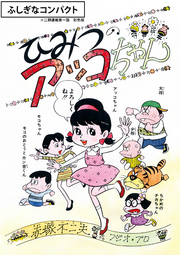
The cast in the debut chapter to the relaunch.
- Ribon (Shueisha): November 1968-December 1969
This run of the manga would be serialized as a tie-in to the new anime airing on TV. Some changes that had been made for the series were now appropriately reflected, such as the creation of the bully Taisho and his brother Shosho. Kankichi's design was also altered to fit the changes made for the anime adaptation. Akko now had the magical mirror compact, and her transformation spell became the "Tekumakumayakon, tekumakumayakon" chant of the Toei anime (with the detransformation phrase of "Ramipus, Ramipus, rurururu").
Ten chapters of the run were either slight revisions of the original Ribon stories, changing panel arrangements and some details, or were entirely redrawn from start to finish. The chapters remade were:
- Moriyama-sensei and Sato-sensei
- An Angel is a Liar
- Selfishness and Fine Clothes
- A Doll Festival with 0 Points (re-titled "A 0-Point Test Score Desperation Party")
- Anmitsu-chan and the Sweet Shop
- Poor Unfortunate Chibi
- The Shoplifter Capture Strategy
- Three Rounds of Cowardice from Sato-sensei
- Kankichi and his Blue-Eyed Friend
- Martian? Moko-chan
In the end, only four other chapters were newly-created, with the debut showing a new origin story with Akko receiving her compact from the Mirror Spirit. In cases of the remade chapters that only had minor revisions, the changes were usually limited to Akko's mirror being redrawn as the compact (and the spell changed) and a new head/face being pasted onto any appearances of Kankichi. In more significant revisions or redraws, Taisho and Shosho would be added to plots in entirely new sequences or there would be other changes and re-arrangements witnessed; Goma appears with Taisho in "A 0-Point Test Score Desperation Party", with them taking the place of two random children from the previous version.
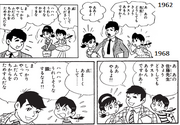
Comparisons between the designs of Akko, Moko, and Sato-sensei between versions of chapter 2.
Changes that did not carry back to the new manga included the presence of Akko's father and Shippona, though Shippona did make it into some tie-ins that were more directly related to the anime series.
Though Akko's design was much different in the anime, that alteration did not carry back to Akatsuka's own art (save for some frontispieces where her head and facial proportions were more closely aligned to the Toei style).
Mushi Pro tankobon revisions[]
However, when it would come to later reprints, the Akebono collection either represented stories from the 2nd Ribon run or instead defaulted to earlier tweaked versions of chapters that had been included in the Mushi Pro tankobon released alongside the anime in 1969.
The Mushi reprints of chapters would present inconsistencies when sourced for later editions such as Akebono, likely due to being set out of order; Sometimes Akko would still have her old mirror (to tie into the fact that Mushi Pro used a redraw of the first chapter rather than the entirely new 1968 origin) but would still chant "Tekumakumayakon" as she would in the anime, while in one case the smaller replacement mirror that she'd receive would be the new compact (which would entirely negate that new Ribon run opening), and sometimes she would simply have the new compact to align with the anime and new origin.

Akko receiving her mirror compact in place of the 2nd magic mirror.
As with the new Ribon run however, the most major and consistent change made to chapters would be a new face for Kankichi being pasted over his appearances. There are cases, however, where there are oversights and where it was forgotten to paste the new face on, such as certain pages of "The Salesman's Goddess" where he has his old face and hairstyle. Such mistakes were corrected in the Star Comics edition.
Picture Book versions[]
Shogakukan[]
- Shogakukan Picture Book: March and November 1969
These were special activity books that contained remakes of various manga chapters, as well as all-new stories created specifically for each volume.
Though these versions of chapters have not seen reprint, the Fujio Akatsuka Museum can be seen to have some original manuscripts for some of the pages on display.
Hikari no Kuni[]
- Dates unknown, through 1971
Two picture books are known to exist: "Akko's Hiking" and "Akko-chan The Detective". Another, "Compact SOS", sometimes appears in Fujio Pro listings as well.
Fun Kindergarten version[]
- Fun Kindergarten: December 1970 to September 1972
A tie-in manga ran in this magazine, with several stories drawn by Fujio Pro assistants in the style of the 1969 anime. While there were many original plot ideas, there were also full-on redraws and remakes of stories from the first Ribon run. It has never been reprinted, and was replaced by Adventurer Miru-chan after it wrapped.
Shogakukan Grade Magazine versions[]
- Growing: March 1970
- Good Kids: January 1969 to November 1970?
- Kindergarten: January to November 1970
- 1st Grade: April to November 1970
- 2nd Grade: April to November 1970
Through the year of 1970, Shogakukan's children and elementary grade school learning magazines had their own features of Akko-chan, due to the continued popularity of the first Toei anime. They wrapped up shortly after it completed its run.
These versions have never seen reprint. Some magazines' comics were illustrated by the Fujio Pro assistants of Takao Yokoyama and Kunio Nagatani, or by artists contracted by Toei Animation (particularly in the case of the Good Kids and Kindergarten versions, where each chapter are basically a picture story with the anime designs). This leads to the characters looking more like the anime versions in some cases, and the coloring for the series tends to be inconsistent.
For such reasons (and possibly leading to the lack of reprints), these versions tend to be overlooked as an Akatsuka work, even if his name was still credited to them.
Young Version one-shot[]
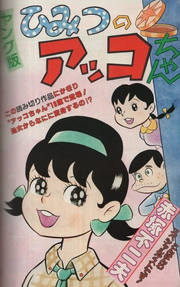
Frontispiece to the one-shot. The page was originally in full color, but had such detail stripped out in reprints by being rendered as a monochrome photocopy.
- Weekly Young Magazine (Kodansha): January 2, 1981
A seinen-geared one-shot by Akatsuka, featuring Akko and Moko now in their final year of high school. A melancholy Akko attempts to find out whether a boy likes her or Moko more, but finds out that he is an embarrassing mazacon ("mama's boy") instead and vows never to use her mirror disguises again after being disturbed by the unpleasant revelation.
Between that twist and an infamous scene of a junior high school-aged Kankichi being caught in a compromising position, the material in this one-shot is more mature-oriented and a little more crude than the classic shojo manga fans had grown up with.
The story was intended from the start as a special one-time project by Akatsuka, having been done specifically for Young Magazine's "Great Master Guest Series"; famous manga authors such as Shotaro Ishinomori ("Second-Class Angel"), Fujiko Fujio A ("Mataro Creeps Up On You"), and others would revisit old works and retool them for the 1980s in one-shot form.
3rd Run[]
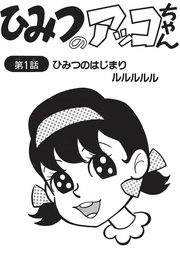
Akko as appearing in the late 1980s.
- Nakayoshi (Kodansha): October 1988-September 1989
Another remake was issued to run alongside the second TV anime by Toei. This time, the series was given a more gag manga spin with more slapstick and rougher expressions, though the subject matter still remained appropriate enough for a kids' level.
Both Akko's parents were present and redesigned, and Akko's cat Shippona and Taisho's henchmen were imported back to the manga with the Queen of Mirrors.
In the meantime, Kodansha's Fun Kindergarten and Otomodachi magazines ran outright tie-in comics to the anime, that were picture stories by Toei Animation artists.
Reprints[]
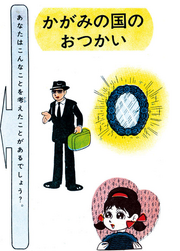
The opening to "The First Errand from the Mirror Country", as it appears in Kinran and in re-releases sourcing from it such as Earth Company and Kawade.
- Kinran Company: 4 volumes (1964). This kashihon (rental manga) version contains color pages, and is the earliest known version in existence.
- Mushi Pro Book: 3 volumes (1969), 2 volumes of "Picture book version" (1971). The first reprint contains a redrawn version of the first chapter that has been used in some subsequent publications, depicting Akko in a design more familiar to her decided look (as she originally lacked her hairband in the first Ribon chapter). Some chapters from the second run appear, although many chapters from the first run also made it in with noticeable changes. Meanwhile, the Mushi picture book volumes are a colored version of the revised manga seen in the previous release.
- Kodansha Color TV Masterpieces: 1 volume (1971)
- Akebono: 6 volumes kashihon (1965), "Complete Works", 5 volumes (1974), 1-volume paperback (1998). While many chapters from the first run (albeit with Mushi Pro's edits) were reprinted in the second release, some other chapters were the completely redrawn versions from the second run. The "Complete Works" release presents an altered ordering of chapters, especially keeping in mind the inconsistency with the redraws in the 2nd serialized run and Mushi Pro reprinted versions.
- Big Company: 3 volumes in their "Star Comics" imprint (1980). This is based upon the second Akebono release, with some of the Mushi Pro edits to chapters.
- Kodansha: 2 volumes (1989), compiling the Nakayoshi run. These were later re-released in English in 2001.
- Earth Publishing: 3 volumes (1994). Re-release of the Kinran Company version, but criticized for the poor reproduction of the image quality.
- Shogakukan: "Pikapika Comics" 3 volumes (2005), "Fujio Akatsuka Complete Works" 8 volume set (2002). The first release mainly reprints the second run, while the second release is a re-bundling of the Akebono "Complete Works" and paperback and also includes the Nakayoshi volumes.The Weekly Young version one-shot can be found in the Akatsuka "1980s" collection from the same imprint.
- Kawade Mook: 4 volumes (2009). This release contains colored versions of chapters sourced from the Kinran reprint of Akko-chan. While branded as the "Complete" version, there are some that feel it inaccurate due to that factor. This release covers the original Ribon run, with some of the new chapters from the second run.
- eBookJapan: 5 volumes (2012). While this release is based upon the previous Kawade edition, the kashihon versions of chapters have been replaced with the original Ribon printings and the chapter structure has become different.
The chapters of "Mary-chan Disturbance", "Defeat the Unpleasant Fool", and "Kankichi-kun's Secret" were all missing from reprints prior to the Kawade Mook release, presumably due to lost or misplaced manuscripts at the time of publishing. Kawade and the following eBookJapan reprint appropriately restore the stories, although the first one contains some picture quality degradation likely due to coming from a photocopy.
Art Style[]
Media[]
Anime[]
See individual pages for detailed information on each adaptation.
Each anime adaptation has its own unique spin on the series, with various character settings being updated for each era. The occupations for Akko's parents are often different, as they are seen as being what a boy and girl's ideal jobs would be in the given time each series was made in.
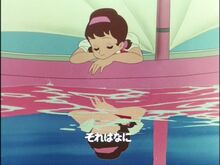
Screencap taken from Akko-chan's first anime (60s). The opening song is used in the other two anime adaptations.
Akko's personality, her fashion, and even her very hair color may change, but the principles remain similar.
- First work: Aired on NET from 1/6/1969 to 10/26/1970 for 94 episodes. It was produced by NET and Toei Animation. It introduced many changes that would resonate to subsequent adaptations, but often has a more melancholy and serious tone. Toei would also later screen five of the episodes theatrically.
- Second work: Aired on Fuji TV from 10/9/1988 to 12/24/1989 for 61 episodes. It was produced by Fuji TV, Toei, and Yomiko Advertising. Although the director Hiroki Shibata wished to emulate the original adaptation, Yomiko and Toei ordered the new series to be brighter and more comedic, which worked to its success. The anime-original characters of Kio and The Strange Old Man were introduced, with the latter designed by Akatsuka. Two theatrical films were released during its run.
- Third work: Aired on Fuji TV from 4/5/1998 to 2/28/1999 for 44 episodes. It was another joint production between Fuji TV, Toei, and Yomiko. The character of Ippei the Penguin was newly created for this series. Unfortunately, the ratings and toy sales were poor, which lead to its early end and no theatrical film plans. As Fujio Pro's work output had decreased by this time, there was no 4th run of the manga to be had although Fun Kindergarten and Otomodachi did run tie-in features with Toei art.
TV Drama[]
Main article: Akko-chan's Got a Secret!: The Story of the Dancing Girl of Izu
A live-action special aired on Fuji TV's Monday Dramaland on February 9, 1987. It was the third and final of their adaptations of Akatsuka's works.
Much like Fuji TV's specials for Osomatsu-kun and Extraordinary Ataro, it has yet to ever receive a home video release and has never been rebroadcast.
Live Action Film[]
Collaboration with Hime Gal Paradise[]
The September 2012 issue of Ciao magazine featured Akko showing up in Akira Wao's manga Hime Gal Paradise, as a way of promoting the live-action adaptation. It was later reprinted in vol.3 of Wao's Tinkle Collection.
Remake Manga: The Secrets of Akko-chan MYU[]
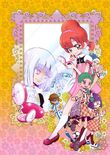
A webcomic written by Hiroshi Izawa and illustrated by the Kamakita Twins began serialization on Comic Spinel on October 21, 2016.
In this updating of the series, Akko is a junior high student who receives the compact as part of a mission given to her by the Queen of Mirrors to protect her son Tokio. New characters were added, such as the compact fairy Chamira, Tokio's servants, his childhood friend Rei, and his twin brother Hinata. While other characters introduced with the anime adaptations such as Taisho, Shippona, Goma, and Gyoro made the transition to this continuity, others present from all previous iterations such as Kankichi and Ganmo were excluded.
The series was put on an unofficial hiatus after the release of the first volume, until it started back up in April 2019 and continued its irregular schedule, falling far behind its promised bimonthly release. The final chapter of the series (24) was not serialized on the website, but instead reserved for a fourth collected edition released on March 25, 2022.
- Homesha: 1 volume (2018)
- Shueisha Home Comics: "New Cover Edition" 4 volumes (2021-2022)
Overseas Releases[]
See also: List of foreign dub names for characters of Akko-chan's Got a Secret!
The revised manga from the Star Comics reprints was sourced for an Italian translation by Fabbri in the early 1980s in issues 216 to 235 of their Candy Candy magazine, only being collected into 1 volume before discontinuation. Outside of Akko being renamed "Stilly" to reflect the official Italian dubbing, other characters' names were inexplicably changed to other Japanese (or what the editorial felt were Japanese-sounding) names; Moko becoming "Kaori" and Kankichi becoming "Isamu", and so on.
In 2001, the two volumes of the Nakayoshi run of the manga were released with an English translation as part of Kodansha's Bilingual Comics imprint in 2001. The characters' names remained intact, other than Taisho and Shosho being localized to "Topdog" and "Bottomdog".
Other than the above attempts, there has been no official localization for the manga.
The anime adaptations would be seen in different countries under these titles:
- Hong Kong: Received all three series. The first series ran under the title 小魔鏡 (Little Mirror) in 1979, while the second series was aired as 魔鏡魔鏡 (Mirror Mirror) by TVB Jade.
- Taiwan: The second series is known as 甜蜜小天使 (Sweet Little Angel) and was aired by CTS.
- South Korea: The 1988 series would later be broadcast on Tooniverse under the title 거울요정 라라 (Mirror Fairy Lala) in 1996.
- Italy: Received all three series, under the respective titles of Lo Specchio Magico, Un Mondo di Magia, and Stilly e lo Specchio Magico. Various characters underwent renaming, and the first series only had the first 86 episodes dubbed. The third series would also receive incomplete dubbing, with 35 out of 44 episodes making the cut.
- France: The second series was localized under the title Caroline, but only the first 52 episodes were dubbed. All characters were renamed.
- Spain: The third series would air under the title El Secreto de Akko.
- Poland: The first series was dubbed as Czarodziejskie Zwierciadełko.
- A Spanish-language dub aired in Latin American countries also exists of the first series, titled Los Secretos de Julie.
Gallery[]
Original Artwork[]
More Revisions of 1st run Ribon Material (relaunch, Mushi Pro and following reprints)[]
These are only some samples of the various changes that can be seen through reprints of chapters. The eBookJapan release goes with the original editions (or reconstructions of such) of each story, and Kawade has near-original versions, having relied on the Kinran kashihon for most of its material.
In an interesting and more recent case, the Shojo Manga-ka: Fujio Akatsuka book partially reverted "Art in Autumn is a Huge Mess" and "Kankichi and the Silent Night" to their original artwork; all changes except those to Kankichi's face were undone.
Covers to Reprints[]
Each cover represents the first volume of a release, unless there was only a single book published in the imprint such as with Akebono Bunko and the Masterpiece Selection.





